Inversion of Cotton Soil and Plant Analytical Development Based on Unmanned Aerial Vehicle Multispectral Imagery and Mixed Pixel Decomposition
Abstract
1. Introduction
2. Materials and Methods
2.1. Experimental Design
2.2. UAV Image Acquisition and Preprocessing
2.3. Cotton Ground Data Collection
2.4. UAV Multi-Source Remote Sensing Image Alignment
2.5. UAV Multispectral Image Segmentation Methods
2.5.1. Vegetation Index Threshold Segmentation Method
2.5.2. Image Segmentation Based on SVM Supervised Classification
2.5.3. Cotton Abundance Information Extraction Based on Mixed Pixel Decomposition
2.6. Vegetation Indices Calculation from UAV Multispectral Imagery
2.7. Cotton SPAD Inversion Model Selection
2.8. Cotton SPAD Inversion Model Accuracy Evaluation Indexes
3. Results and Analysis
3.1. Accuracy Analysis of Different Segmentation Methods for UAV Multispectral Images
3.2. Correlation Analysis between Vegetation Indices and Cotton SPAD
3.3. Cotton SPAD Inversion Model Construction
3.4. SPAD Spatiotemporal Mapping Based on Optimal Inversion Modeling
4. Discussions
5. Conclusions
Author Contributions
Funding
Institutional Review Board Statement
Data Availability Statement
Conflicts of Interest
References
- Zhang, L.; Sun, B.; Zhao, D.; Shan, C.; Wang, G.; Song, C.; Chen, P.; Lan, Y. Prediction of Cotton FPAR and Construction of Defoliation Spraying Prescription Map Based on Multi-source UAV Images. Comput. Electron. Agric. 2024, 220, 108897. [Google Scholar] [CrossRef]
- Xu, W.; Chen, P.; Zhan, Y.; Chen, S.; Zhang, L.; Lan, Y. Cotton Yield Estimation Model Based on Machine Learning Using Time Series UAV Remote Sensing Data. Int. J. Appl. Earth Obs. Geoinf. 2021, 104, 102511. [Google Scholar] [CrossRef]
- Zhang, S.; Zhao, G.; Lang, K.; Su, B.; Chen, X.; Xi, X.; Zhang, H. Integrated Satellite, Unmanned Aerial Vehicle (UAV) and Ground Inversion of the SPAD of Winter Wheat in the Reviving Stage. Sensors 2019, 19, 1485. [Google Scholar] [CrossRef] [PubMed]
- Zhuo, W.; Wu, N.; Shi, R.; Wang, Z. UAV Mapping of the Chlorophyll Content in a Tidal Flat Wetland Using a Combination of Spectral and Frequency Indices. Remote Sens. 2022, 14, 827. [Google Scholar] [CrossRef]
- Zhao, X.; Li, Z.; Wang, H.; Liu, J.; Jiang, W.; Zhao, Z.; Wang, X.; Gao, Y. Estimation of Chlorophyll Content in Cotton Canopy Using UAV Multispectral Imagery and Machine Learning Algorithms. Cotton Sci. 2024, 36, 1–13. [Google Scholar]
- Delavarpour, N.; Koparan, C.; Nowatzki, J.; Bajwa, S.; Sun, X. A Technical Study on UAV Characteristics for Precision Agriculture Applications and Associated Practical Challenges. Remote Sens. 2021, 13, 1204. [Google Scholar] [CrossRef]
- Tsouros, D.C.; Bibi, S.; Sarigiannidis, P.G. A Review on UAV-Based Applications for Precision Agriculture. Information 2019, 10, 349. [Google Scholar] [CrossRef]
- Liu, Z.; Wan, W.; Huang, J.; Han, Y.; Wang, J. Progress on Key Parameters Inversion of Crop Growth Based on Unmanned Aerial Vehicle Remote Sensing. Trans. Chin. Soc. Agric. Eng. 2018, 34, 60–71. [Google Scholar]
- Qu, Y.; Tang, Y.; Zhou, Z.; Yan, F.; Wang, J.; Xu, H.; Hu, L.; Xu, X. Study on Model Simulation of Relative Chlorophyll Content of Moso Bamboo Based on UAV Visible Light Image. Acta Agric. Univ. Jiangxiensis 2022, 44, 139–150. [Google Scholar]
- Wang, S.; Kong, Y.; Zhang, Z.; Chen, H.; Liu, P. SPAD Value Inversion of Cotton Leaves Based on Satellite-UAV Spectral Fusion. Sci. Agric. Sin. 2022, 55, 4823–4839. [Google Scholar]
- Ji, W.; Chen, H.; Wang, S.; Zhang, Y. Modeling Method of Cotton Leaves SPAD at Flowering and Boll Stage in North China Plain Based on UAV Multi-Spectrum. Chin. Agric. Sci. Bull. 2021, 37, 143–150. [Google Scholar]
- Ao, D.; Yang, J.; Ding, W.; An, S.; He, L. Review of 54 vegetation indices. J. Anhui Agric. Sci. 2023, 51, 13–21, 28. [Google Scholar]
- Zhou, Z.; Gu, X.; Cheng, Z.; Chang, T.; Zhao, T.; Wang, Y.; Du, Y. Inversion of Chlorophyll Content of Film-Mulched Maize Based on Image Segmentation. Sci. Agric. Sin. 2024, 57, 1066–1079. [Google Scholar]
- Wei, C.; Du, Y.; Cheng, Z.; Zhou, Z.; Gu, X. Yield Estimation of Mulched Winter Wheat Based on UAV Remote Sensing Optimized by Vegetation Index. Trans. Chin. Soc. Agric. Mach. 2024, 55, 146–154, 175. [Google Scholar]
- Deng, S.; Zhao, Y.; Bai, X.; Li, X.; Sun, Z.; Liang, J.; Li, Z.; Cheng, S. Inversion of Chlorophyll and Leaf Area Index for Winter Wheat Based on UAV Image Segmentation. Trans. Chin. Soc. Agric. Eng. 2022, 38, 136–145. [Google Scholar]
- Li, M.; Zhu, X.; Bai, X.; Peng, Y.; Tian, Z.; Jiang, Y. Remote Sensing Inversion of Nitrogen Content in Apple Canopy Based on Shadow Removal in UAV Multi-Spectral Remote Sensing Images. Sci. Agric. Sin. 2021, 54, 2084–2094. [Google Scholar]
- Meng, D.; Zhao, J.; Lan, Y.; Yang, C.; Yang, D.; Wen, Y. Study on SPAD Inversion Model of Maize Canopy Based on UAV Visible Light Images. Trans. Chin. Soc. Agric. Mach. 2020, 51 (Suppl. S2), 366–374. [Google Scholar]
- Zhang, N.; Zhang, X.; Bai, T.; Yuan, X.; Ma, R.; Li, L. Field Scale Cotton Land Feature Recognition Based on UAV Visible Light Images in Xinjiang. Trans. Chin. Soc. Agric. Mach. 2023, 54 (Suppl. S2), 199–205. [Google Scholar]
- Han, J.; Feng, C.; Peng, J.; Wang, Y.; Shi, D. Estimation of Leaf Area Index of Cotton from Unmanned Aerial Vehicle Multispectral Images with Different Resolutions. Cotton Sci. 2022, 34, 338–349. [Google Scholar]
- Jia, D.; Chen, P. Effect of Low-Altitude UAV Image Effect of Low—Altitude UAV Image Resolution on Inversion of Winter Wheat Nitrogen Concentration. Trans. Chin. Soc. Agric. Mach. 2020, 51, 164–169. [Google Scholar]
- Liu, Y.; Feng, H.; Sun, Q.; Yang, F.; Yang, G. Estimation Study of Above Ground Biomass in Potato Based on UAV Digital Images With Different Resolutions. Spectrosc. Spectr. Anal. 2021, 41, 1470–1476. [Google Scholar]
- Yuan, N.; Gong, Y.; Fang, S.; Liu, Y.; Duan, B.; Yang, K.; Wu, X.; Zhu, R. UAV Remote Sensing Estimation of Rice Yield Based on Adaptive Spectral Endmembers and Bilinear Mixing Model. Remote Sens. 2021, 13, 2190. [Google Scholar] [CrossRef]
- Lyngdoh, R.B.; Dave, R.; Anand, S.S.; Ahmad, T.; Misra, A. Hyperspectral Unmixing With Spectral Variability Using Endmember Guided Probabilistic Generative Deep Learning. In Proceedings of the GARSS 2022–2022 IEEE International Geoscience and Remote Sensing Symposium, Kuala Lumpur, Malaysia, 17–22 July 2022; IEEE: New York, NY, USA, 2022; pp. 1768–1771. [Google Scholar]
- Yu, F.; Zhao, D.; Guo, Z.; Jin, Z.; Guo, S.; Chen, C.; Xu, T. Characteristic Analysis and Decomposition of Mixed Pixels From UAV Hyperspectral Images in Rice Tillering Stage. Spectrosc. Spectr. Anal. 2022, 42, 947–953. [Google Scholar]
- Li, D.; Sun, Z.; Jia, G. Remote Sensing Image Analysis of Forest Land in Lushan Mountain and Its Surrounding Area Based on Mixed Pixel Decomposition. For. Inventory Plan. 2023, 48, 127. [Google Scholar]
- Su, X.; Wang, J.; Din, L.; Lu, J.; Zhang, J.; Yao, X.; Cheng, T.; Zhu, Y.; Cao, W.; Tian, Y. Grain Yield Prediction Using Multi-Temporal UAV-Based Multispectral Vegetation Indices and Endmember Abundance in Rice. Field Crops Res. 2023, 299, 108992. [Google Scholar] [CrossRef]
- Gong, Y.; Duan, B.; Fang, S.; Zhu, R.; Wu, X.; Ma, Y.; Peng, Y. Remote Estimation of Rapeseed Yield with Unmanned Aerial Vehicle (UAV) Imaging and Spectral Mixture Analysis. Plant Methods 2018, 14, 1–14. [Google Scholar] [CrossRef]
- Duan, B.; Fang, S.; Zhu, R.; Wu, X.; Wang, S.; Gong, Y.; Peng, Y. Remote Estimation of Rice Yield with Unmanned Aerial Vehicle (UAV) Data and Spectral Mixture Analysis. Front. Plant Sci. 2019, 10, 204. [Google Scholar] [CrossRef]
- Xu, H.; Lan, Y.; Zhang, S.; Tian, B.; Yu, H.; Wang, X.; Zhao, S.; Wang, Z.; Yang, D.; Zhao, J. Research on Vegetation Cover Extraction Method of Summer Maize Based on UAV Visible Light Image. Int. J. Precis. Agric. Aviat. 2018, 1, 44–51. [Google Scholar] [CrossRef]
- Liao, C.; Zhang, X.; Liu, Y. Remote Sensing Retrieval of Vegetation Coverage in Arid Areas Based on Multiple Endmember Spectral Unmixing. Chin. J. Appl. Ecol. 2012, 23, 3243–3249. [Google Scholar]
- Wang, Y.; Tan, S.; Jia, X.; Qi, L.; Liu, S.; Lu, H.; Wang, C.; Liu, W.; Zhao, X.; He, L.; et al. Estimating Relative Chlorophyll Content in Rice Leaves Using Unmanned Aerial Vehicle Multi-Spectral Images and Spectral–Textural Analysis. Agronomy 2023, 13, 1541. [Google Scholar] [CrossRef]
- Tian, J.; Yang, Z.; Feng, K.; Ding, X. Prediction of Tomato Canopy SPAD Based on UAV Multispectral Image. Trans. Chin. Soc. Agric. Mach. 2020, 51, 178–188. [Google Scholar]
- Tahir, M.; Naqvi, S.; Lan, Y.; Zhang, Y.; Wang, Y.; Afzal, M.; Cheema, M.; Amir, S. Real Time Estimation of Chlorophyll Content Based on Vegetation Indices Derived from Multispectral UAV in the Kinnow Orchard. Int. J. Precis. Agric. Aviat. 2018, 1, 24–31. [Google Scholar]
- Pan, F.; Li, W.; Lan, Y.; Liu, X.; Miao, J.; Xiao, X.; Xu, H.; Lu, L.; Zhao, J. SPAD Inversion of Summer Maize Combined with Multi-source Remote Sensing Data. Int. J. Precis. Agric. Aviat. 2018, 1, 45–52. [Google Scholar] [CrossRef]
- Dash, J.; Curran, P.J. The MERIS Terrestrial Chlorophyll Index. Int. J. Remote Sens. 2004, 25, 5403–5413. [Google Scholar] [CrossRef]
- Cao, Q.; Miao, Y.; Shen, J.; Yu, W.; Yuan, F.; Cheng, S.; Huang, S.; Wang, H.; Yang, W.; Liu, F. Improving in-season Estimation of Rice Yield Potential and Responsiveness to Topdressing Nitrogen Application with Crop Circle Active Crop Canopy Sensor. Precis. Agric. 2015, 17, 136–154. [Google Scholar] [CrossRef]
- Daughtry, C.T.; Walthall, C.L.; Kim, M.S.; Colstoun, E.B.D.; McMurtrey, J.E. Estimating Corn Leaf Chlorophyll Concentration from Leaf and Canopy Reflectance. Remote Sens. Environ. 2000, 74, 229–239. [Google Scholar] [CrossRef]
- Qi, H.; Wu, Z.; Zhang, L.; Li, J.; Zhou, J.; Jun, Z.; Zhu, B. Monitoring of Peanut Leaves Chlorophyll Content Based on Drone-based Multispectral Image Feature Extraction. Comput. Electron. Agric. 2021, 187, 106292. [Google Scholar] [CrossRef]
- Noh, H.; Zhang, Q. Shadow Effect on Multi-spectral Image for Detection of Nitrogen Deficiency in Corn. Comput. Electron. Agric. 2012, 83, 52–57. [Google Scholar] [CrossRef]
- Chen, P.; Liang, F. Cotton Nitrogen Nutrition Diagnosis Based on Spectrum and Texture Feature of lmages from Low Altitude Unmanned Aerial Vehicle. Sci. Agric. Sin. 2019, 52, 2220–2229. [Google Scholar]
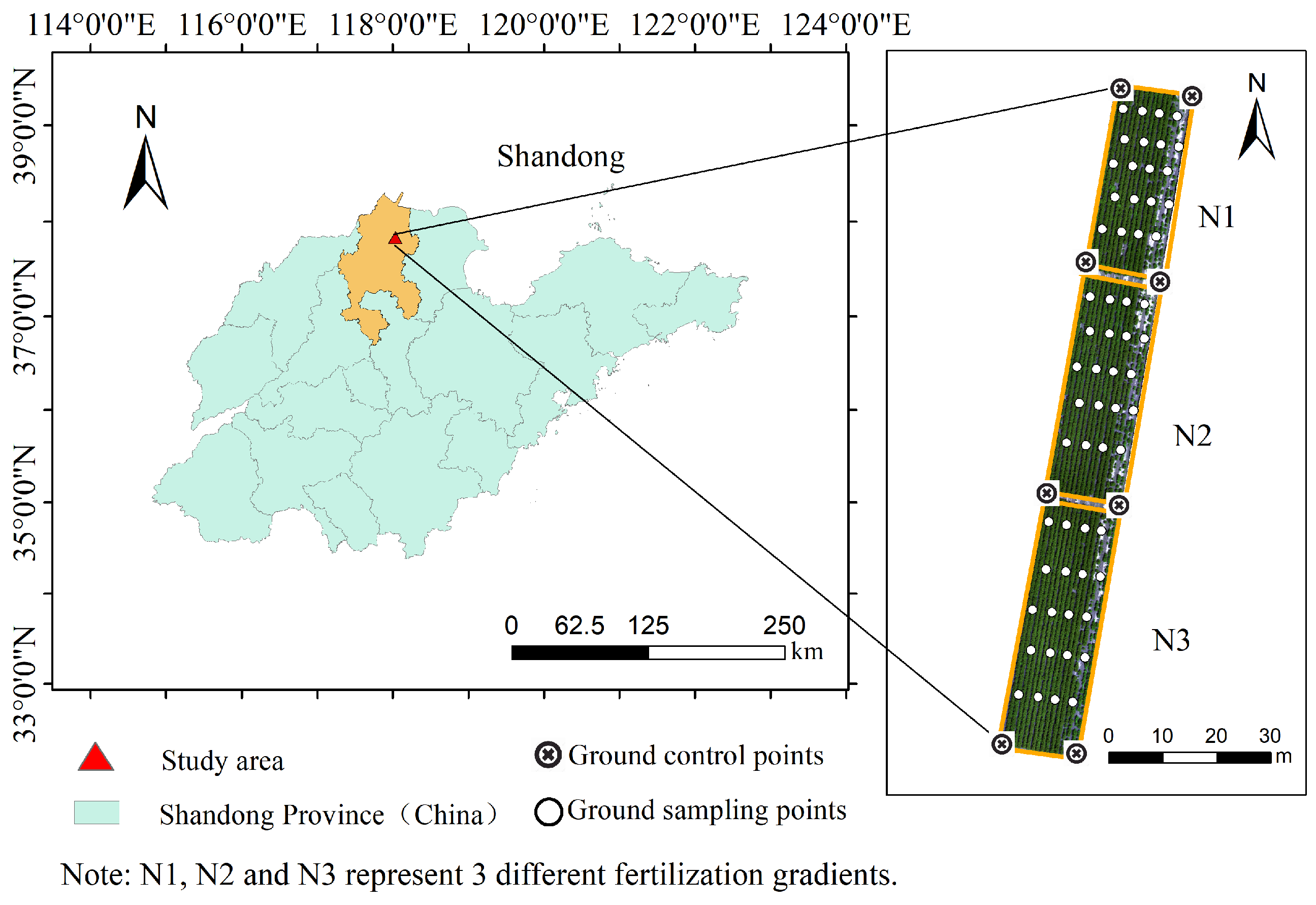

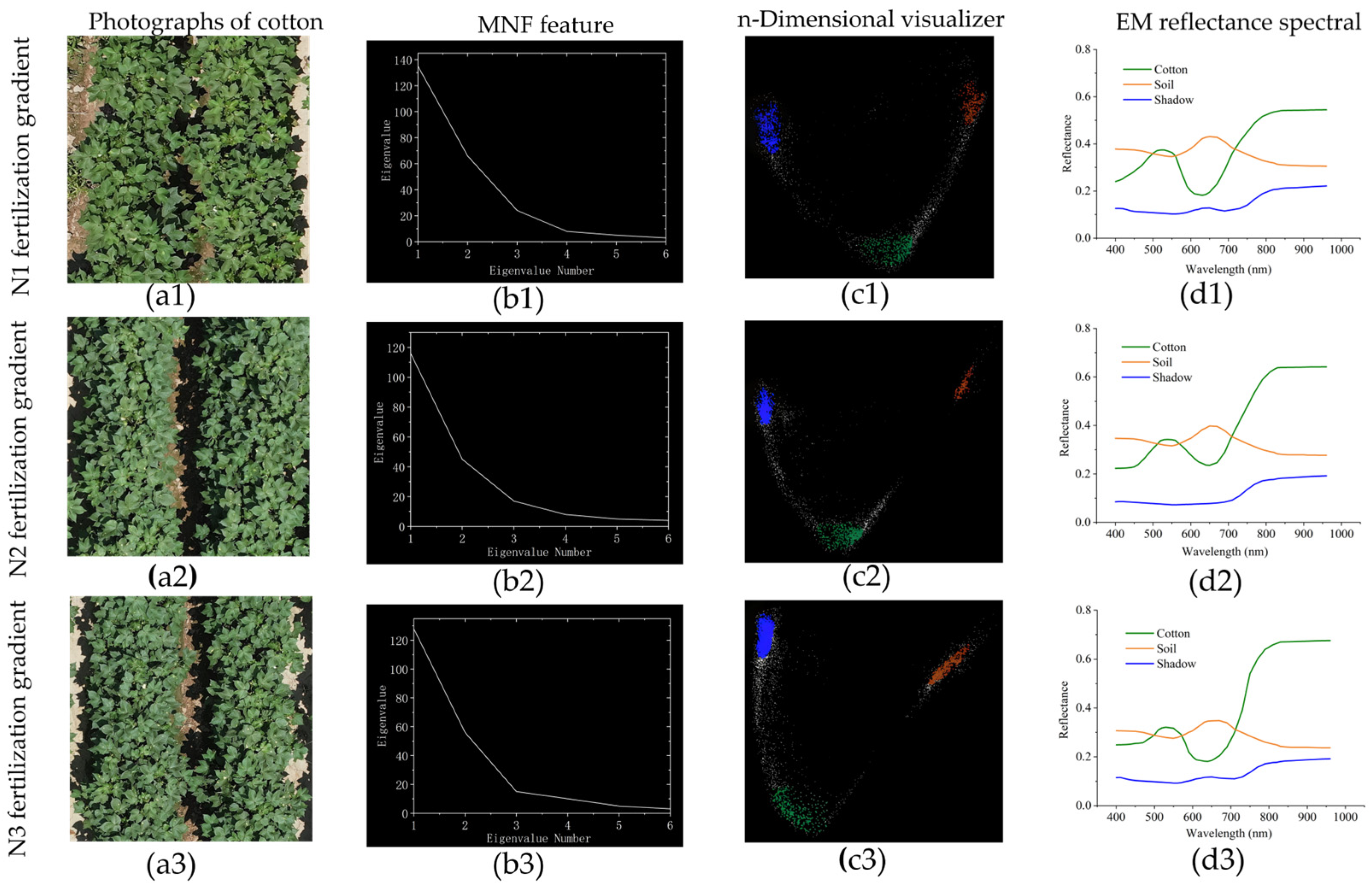
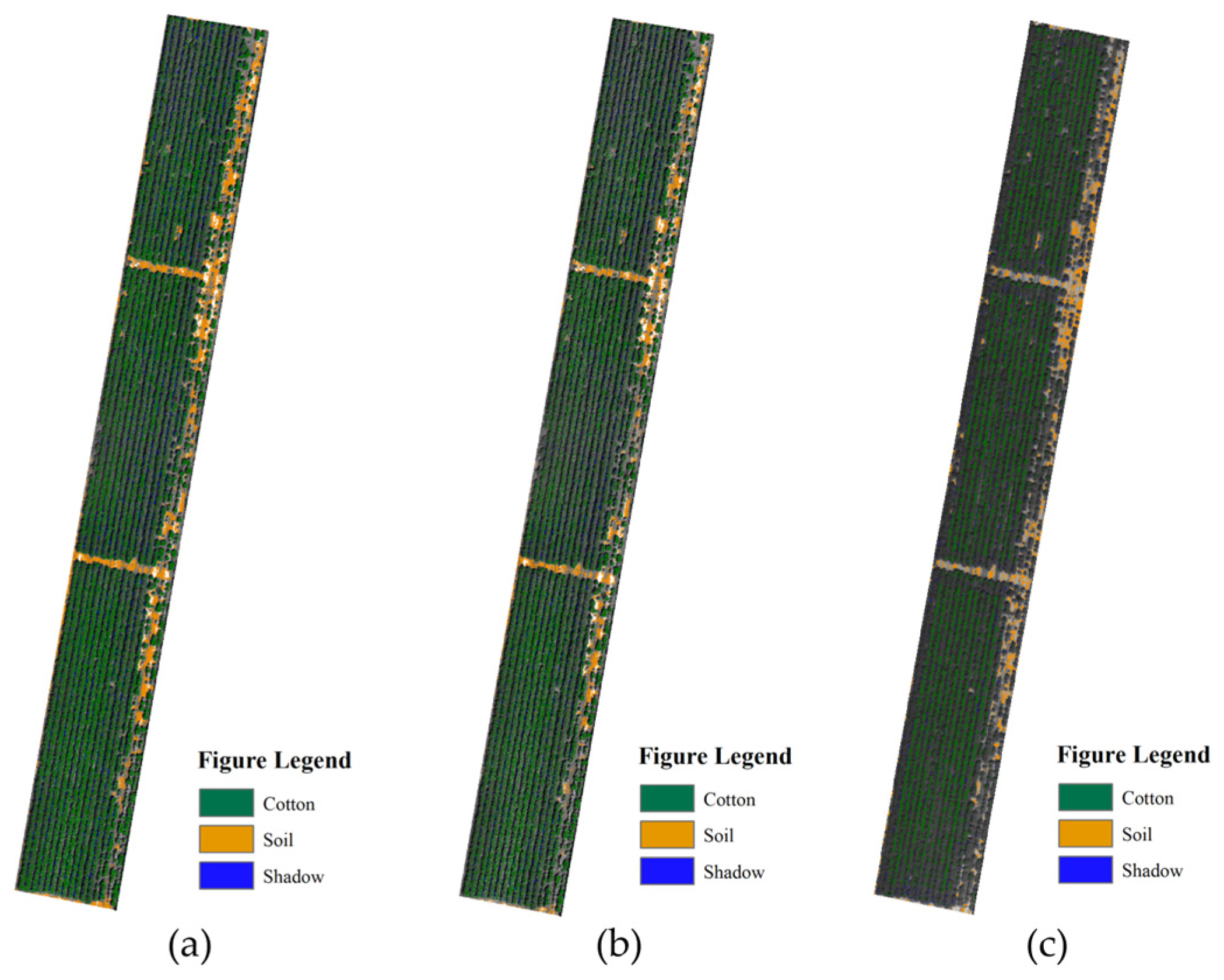
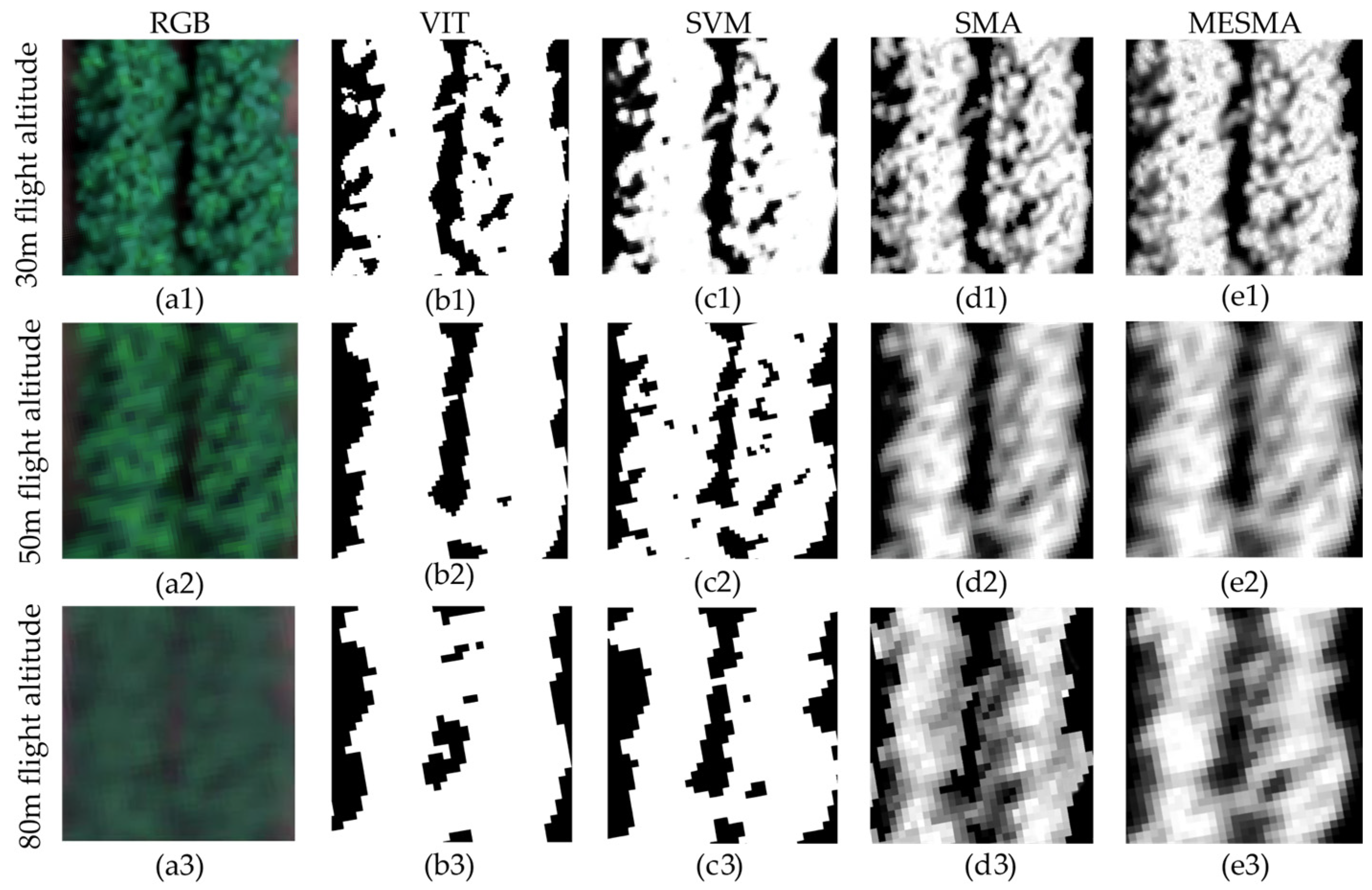

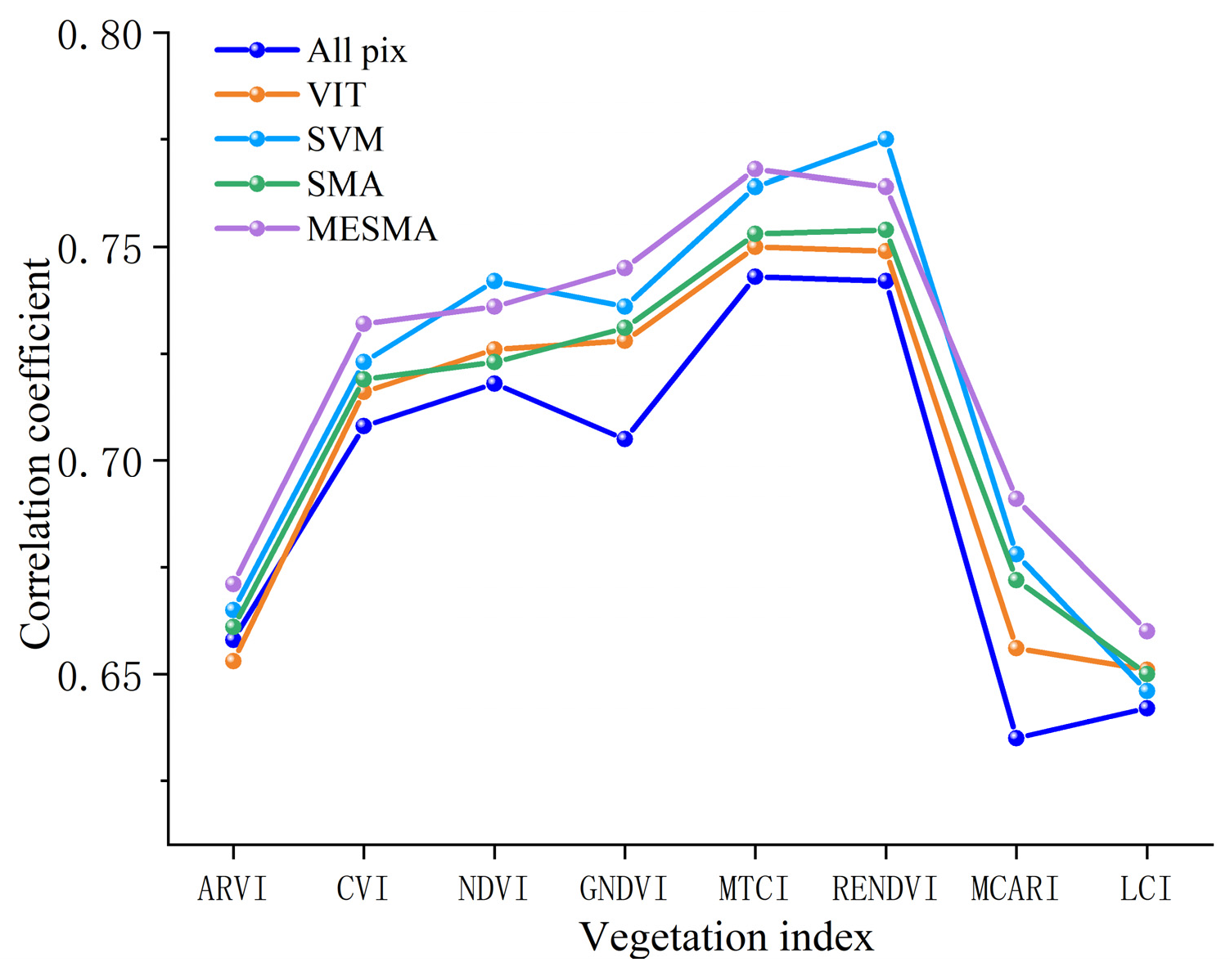
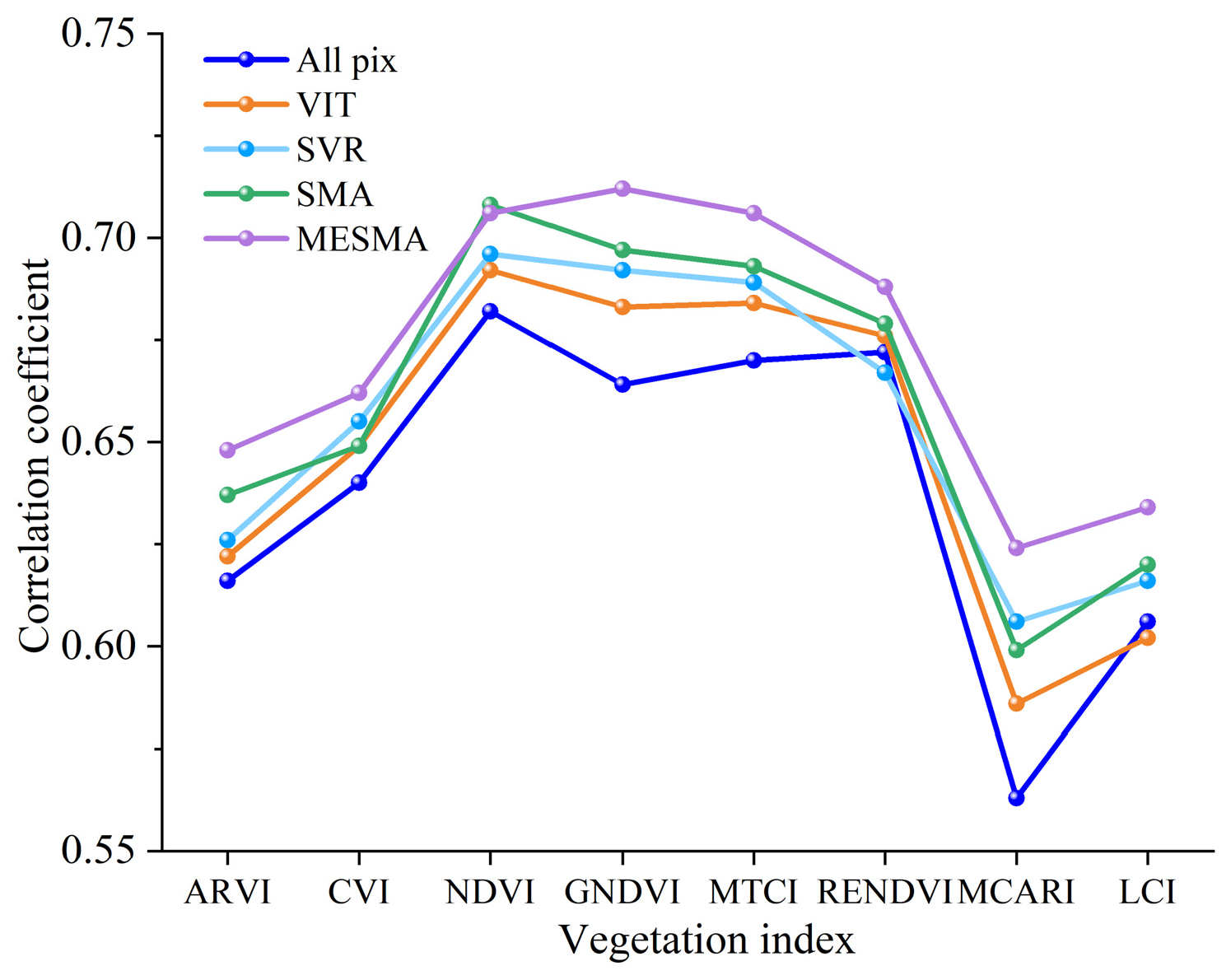


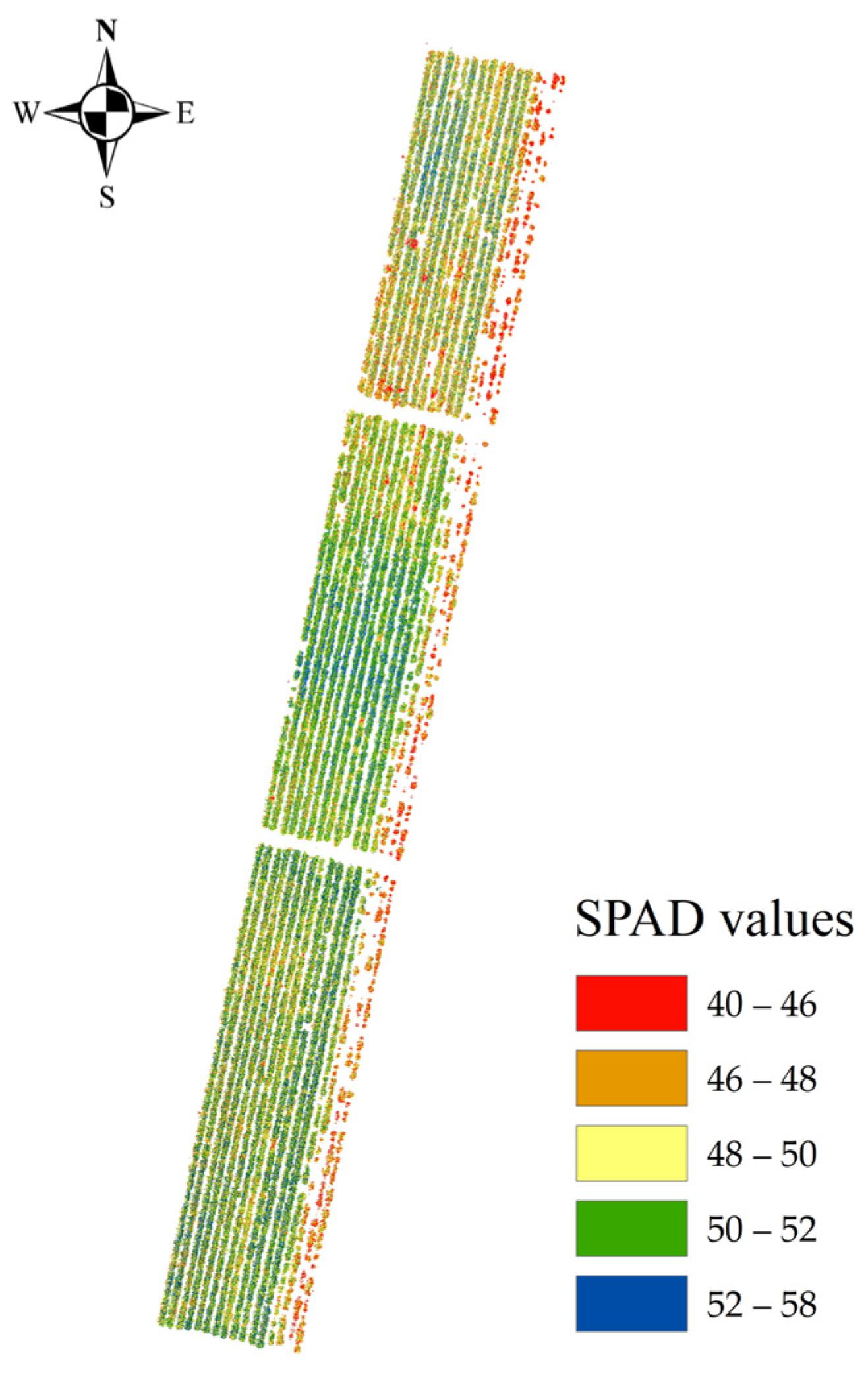
| Nitrogen Fertilizer Gradient | Number of Cotton SPAD Observed | Mean | Max | Min | SD | CV (%) |
|---|---|---|---|---|---|---|
| N1 region | 20 | 46.94 | 51.1 | 42.0 | 2.58 | 5.49 |
| N2 region | 20 | 50.86 | 54.8 | 46.3 | 2.40 | 4.71 |
| N3 region | 20 | 49.62 | 53.3 | 44.2 | 2.44 | 4.91 |
| whole region | 60 | 49.13 | 54.8 | 42 | 3.16 | 6.43 |
| Altitude | Mixed Pixels % | Cotton Pixels % | Soil Pixels % | Shadow Pixels % |
|---|---|---|---|---|
| 30 m | 58.2% | 23.5% | 14.2% | 4.1% |
| 50 m | 66.7% | 17.4% | 12.1% | 3.8% |
| 80 m | 76.4% | 11.1% | 9.6% | 2.9% |
| Vegetation Index | Calculation Formula | Reference |
|---|---|---|
| Atmospheric resistant vegetation index (ARVI) | / | [31] |
| Chlorophyll vegetation index (CVI) | [32] | |
| Normalized difference vegetation index (NDVI) | [33] | |
| Green normalized difference vegetation index (GNDVI) | )/() | [34] |
| Meris terrestrial chlorophyll index (MTCI) | )/() | [35] |
| Rededge normalized difference vegetation index (RENDVI) | )/( + REG) | [36] |
| Modified chlorophyll absorption reflectance index (MCARI) | [37] | |
| Leaf chlorophyll index (LCI) | [38] |
| Segmentation Method | 30 m | 50 m | 80 m | |||
|---|---|---|---|---|---|---|
| Cotton Proportion% | Average Error% | Cotton Proportion% | Average Error% | Cotton Proportion% | Average Error% | |
| VIT | 64.34 | 2.95% | 66.74 | 1.97% | 72.51 | 7.05% |
| 65.57 | 70.26 | 76.83 | ||||
| 66.84 | 71.34 | 77.39 | ||||
| SVM | 69.72 | 2.14% | 70.75 | 3.83% | 63.62 | 5.61% |
| 70.75 | 72.94 | 62.22 | ||||
| 71.53 | 73.38 | 62.91 | ||||
| SMA | 65.83 | 2.85% | 66.25 | 3.62% | 64.31 | 4.82% |
| 64.68 | 63.97 | 61.69 | ||||
| 66.52 | 64.52 | 65.14 | ||||
| MESMA | 67.14 | 1.74% | 66.36 | 2.55% | 65.82 | 3.61% |
| 65.52 | 65.14 | 63.31 | ||||
| 67.70 | 66.43 | 65.63 | ||||
| Model | Segmentation Method | Training | Validation | ||||
|---|---|---|---|---|---|---|---|
| R2 | RMSE | MAE | R2 | RMSE | MAE | ||
| PLSR | All pix | 0.682 | 1.65 | 1.36 | 0.637 | 1.59 | 1.43 |
| VIT | 0.725 | 1.53 | 1.24 | 0.679 | 1.51 | 1.30 | |
| SVM | 0.748 | 1.45 | 1.13 | 0.706 | 1.43 | 1.15 | |
| SMA | 0.738 | 1.47 | 1.18 | 0.688 | 1.56 | 1.42 | |
| MESMA | 0.753 | 1.43 | 1.17 | 0.701 | 1.46 | 1.18 | |
| FR | All pix | 0.725 | 1.52 | 1.27 | 0.662 | 1.62 | 1.36 |
| VIT | 0.757 | 1.42 | 1.11 | 0.703 | 1.51 | 1.22 | |
| SVM | 0.774 | 1.37 | 1.16 | 0.722 | 1.45 | 1.17 | |
| SMA | 0.767 | 1.39 | 1.16 | 0.696 | 1.53 | 1.31 | |
| MESMA | 0.779 | 1.35 | 1.12 | 0.728 | 1.43 | 1.16 | |
| SVR | All pix | 0.768 | 1.31 | 1.05 | 0.734 | 1.45 | 1.22 |
| VIT | 0.823 | 1.13 | 0.91 | 0.772 | 1.35 | 1.13 | |
| SVM | 0.841 | 1.07 | 0.76 | 0.794 | 1.31 | 1.08 | |
| SMA | 0.837 | 1.10 | 0.85 | 0.786 | 1.32 | 1.11 | |
| MESMA | 0.849 | 1.05 | 0.67 | 0.810 | 1.27 | 1.04 | |
| Model | Segmentation Method | Training | Validation | ||||
|---|---|---|---|---|---|---|---|
| R2 | RMSE | MAE | R2 | RMSE | MAE | ||
| PLSR | All pix | 0.668 | 1.74 | 1.38 | 0.635 | 1.69 | 1.50 |
| VIT | 0.691 | 1.54 | 1.25 | 0.648 | 1.65 | 1.44 | |
| SVM | 0.707 | 1.50 | 1.26 | 0.646 | 1.67 | 1.41 | |
| SMA | 0.712 | 1.49 | 1.26 | 0.659 | 1.56 | 1.34 | |
| MESMA | 0.728 | 1.52 | 1.24 | 0.672 | 1.52 | 1.32 | |
| FR | All pix | 0.689 | 1.58 | 1.29 | 0.633 | 1.76 | 1.55 |
| VIT | 0.712 | 1.51 | 1.19 | 0.655 | 1.67 | 1.38 | |
| SVM | 0.754 | 1.45 | 1.16 | 0.685 | 1.55 | 1.42 | |
| SMA | 0.740 | 1.46 | 1.14 | 0.696 | 1.57 | 1.31 | |
| MESMA | 0.769 | 1.32 | 1.01 | 0.718 | 1.53 | 1.26 | |
| SVR | All pix | 0.718 | 1.53 | 1.16 | 0.682 | 1.62 | 1.33 |
| VIT | 0.74 | 1.46 | 1.12 | 0.699 | 1.57 | 1.25 | |
| SVM | 0.768 | 1.31 | 0.95 | 0.727 | 1.51 | 1.22 | |
| SMA | 0.773 | 1.25 | 0.96 | 0.744 | 1.48 | 1.21 | |
| MESMA | 0.809 | 1.21 | 0.93 | 0.778 | 1.46 | 1.16 | |
| Model | Segmentation Method | Training | Validation | ||||
|---|---|---|---|---|---|---|---|
| R2 | RMSE | MAE | R2 | RMSE | MAE | ||
| PLSR | All pix | 0.606 | 1.80 | 1.41 | 0.565 | 1.86 | 1.62 |
| VIT | 0.614 | 1.87 | 1.43 | 0.534 | 1.94 | 1.67 | |
| SVM | 0.651 | 1.68 | 1.35 | 0.608 | 1.77 | 1.65 | |
| SMA | 0.695 | 1.62 | 1.34 | 0.641 | 1.65 | 1.58 | |
| MESMA | 0.714 | 1.57 | 1.22 | 0.663 | 1.54 | 1.48 | |
| FR | All pix | 0.619 | 1.82 | 1.41 | 0.554 | 1.82 | 1.68 |
| VIT | 0.626 | 1.75 | 1.45 | 0.568 | 1.78 | 1.53 | |
| SVM | 0.667 | 1.66 | 1.40 | 0.591 | 1.75 | 1.51 | |
| SMA | 0.687 | 1.60 | 1.25 | 0.605 | 1.72 | 1.49 | |
| MESMA | 0.732 | 1.48 | 1.16 | 0.614 | 1.72 | 1.45 | |
| SVR | All pix | 0.663 | 1.63 | 1.32 | 0.591 | 1.88 | 1.61 |
| VIT | 0.671 | 1.64 | 1.37 | 0.604 | 1.78 | 1.48 | |
| SVM | 0.695 | 1.55 | 1.28 | 0.625 | 1.74 | 1.50 | |
| SMA | 0.721 | 1.52 | 1.23 | 0.672 | 1.63 | 1.45 | |
| MESMA | 0.740 | 1.46 | 1.12 | 0.697 | 1.58 | 1.27 | |
Disclaimer/Publisher’s Note: The statements, opinions and data contained in all publications are solely those of the individual author(s) and contributor(s) and not of MDPI and/or the editor(s). MDPI and/or the editor(s) disclaim responsibility for any injury to people or property resulting from any ideas, methods, instructions or products referred to in the content. |
© 2024 by the authors. Licensee MDPI, Basel, Switzerland. This article is an open access article distributed under the terms and conditions of the Creative Commons Attribution (CC BY) license (https://creativecommons.org/licenses/by/4.0/).
Share and Cite
Tian, B.; Yu, H.; Zhang, S.; Wang, X.; Yang, L.; Li, J.; Cui, W.; Wang, Z.; Lu, L.; Lan, Y.; et al. Inversion of Cotton Soil and Plant Analytical Development Based on Unmanned Aerial Vehicle Multispectral Imagery and Mixed Pixel Decomposition. Agriculture 2024, 14, 1452. https://doi.org/10.3390/agriculture14091452
Tian B, Yu H, Zhang S, Wang X, Yang L, Li J, Cui W, Wang Z, Lu L, Lan Y, et al. Inversion of Cotton Soil and Plant Analytical Development Based on Unmanned Aerial Vehicle Multispectral Imagery and Mixed Pixel Decomposition. Agriculture. 2024; 14(9):1452. https://doi.org/10.3390/agriculture14091452
Chicago/Turabian StyleTian, Bingquan, Hailin Yu, Shuailing Zhang, Xiaoli Wang, Lei Yang, Jingqian Li, Wenhao Cui, Zesheng Wang, Liqun Lu, Yubin Lan, and et al. 2024. "Inversion of Cotton Soil and Plant Analytical Development Based on Unmanned Aerial Vehicle Multispectral Imagery and Mixed Pixel Decomposition" Agriculture 14, no. 9: 1452. https://doi.org/10.3390/agriculture14091452
APA StyleTian, B., Yu, H., Zhang, S., Wang, X., Yang, L., Li, J., Cui, W., Wang, Z., Lu, L., Lan, Y., & Zhao, J. (2024). Inversion of Cotton Soil and Plant Analytical Development Based on Unmanned Aerial Vehicle Multispectral Imagery and Mixed Pixel Decomposition. Agriculture, 14(9), 1452. https://doi.org/10.3390/agriculture14091452





